GyeongGi Cultural Foundation
Pocheon_Traces of Liberation and War
As a province adjacent to Seoul, the country's capital city, Gyeonggi-do has inherited a vast amount of Korea's modern cultural heritage as the country has undergone a turbulent modern history, ranging from the latter part of the Joseon Dynasty to the Japanese Occupation Period followed by the national liberation and division, the Korean War, and the impressive industrialization and democratization processes. “Modern Cultural Heritage of Gyeonggi” will feature an introduction to the modern culture of Gyeonggi-do together with a discussion about the history, identity and values of the Province in terms of cultural heritage. |
Writer | Ho-jin Choi
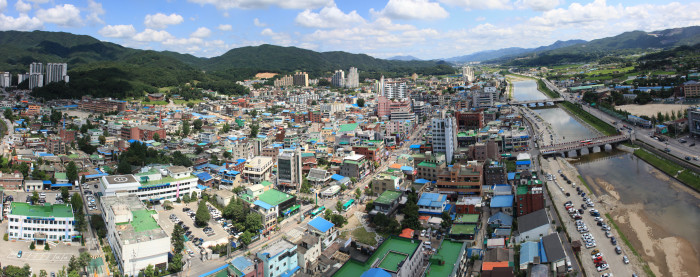
Aerial photo of the site of Pocheon City Hall located between the river, road, and mountain
(source: Pocheon City Hall website)
Pocheon was named so in the 13th year of Joseon's King Taejong (1413). The region had the name of Pocheon in the Three Kingdoms Period, Poju (抱州) in the Goryeo period, then Pocheon (抱川) again in the Joseon Period. It is home for many historic figures, gorgeous nature, and historic sites, but was is during the modern era, the age of liberation and war, that the city was shaped into what it is today.
As there are layers of mountains and rivers in Pocheon, you can find here and there the royal tombs of the Joseon Dynasty, the arboretum, and the flood control facilities in the district. During the Japanese Colonial Era and the war, places like the Forest Practice Research Center and Sanjeong Lake were settled. There are also many war-related heritages such as the ‘June 25 Battlefield’ and the monument in commemoration of recovery, as there is the reclaimed land after the Korean war in Pocheon. Today, the northern borderline of the administrative district of Pocheon is 13 km from the Military Demarcation Line.
War broke out right after the liberation in August 1945, and Pocheon was divided into two as the U.S. and the Soviet armies were stationed facing each other at the 38th parallel north. Parts of Changsu-myeon, Cheongsan-myeon, Yeongjung-myeon, and Ildong-myeon along with Yeongbuk-myeon and Idong-myeon were under Soviet military administration, while the remaining 10 myeons and 67 ris were under U.S. military administration. On August 15, 1948, the government of the Republic of Korea received control of the areas held by the U.S. military government. During the Korean War, however, people evacuated and returned to the region. In 1951, the government office was completely destroyed by fire, so the temporary government building was built at Eoryong-ri, Pocheon-myeon, then moved to the current site at Sineup-ri, Pocheon-gun, in November of the same year.
The period of growth after the war made Pocheon-gun rise in status to an urban and agricultural complex si (city) on October 19, 2003. Pocheon-eup was divided into 2 dongs at the time. Today, Pocheon-si is 826.57 ㎢, corresponding to 8.1% of the area of Gyeonggi-do, and its administrative district consists of 1 eup, 11 myeons, and 2 dongs. As of March 2017, its population is 154 thousand, and the registered foreign residents living in the area are over 12 thousand. It is becoming a complex city of urban, agricultural, and industrial facilities.
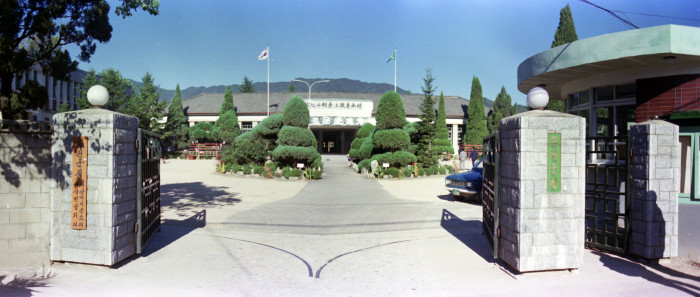
Pocheon-gun Office in 1977, which no longer remains (source: Pocheon City Hall website)
Center of the City of Pocheon
Pocheon City Hall has been standing at Sineup-dong since 1951. Sineup-dong plays the central administrative role, and in addition to the village that was formed at the foot of the mountains, the city started to largely expand between the National Highway 43 that goes beside the Pocheoncheon Stream and Wangbangsan Mountain, around the liberation and the war period. There is farm-cultivating countryside at the base of Wangbangsan Mountain in Eoryong-dong, and Korean traditional houses still remain that were built in the 1940s. The center of administration is less than 3 km apart. Following the expansion of the city, the university campus and the industrial complex came to occupy larger territories, diversifying the environment of the city of Pocheon.

The landscape of Jajak-dong, Pocheon-si (source: Pocheon City Hall website)
Modern and Contemporary Landscape of an Urban and Agricultural Complex City
The recent opening of the expressway linking Guri-Pocheon facilitated the traffic of Pocheon, but there is still inconvenience in the metropolitan subway and transportation network. Even so, the constant efforts by the city of Pocheon to improve its traffic conditions show promise in easing access to the city.
Presently, the landscape of the area where Pocheon City Hall stands spreads out around National Highway 87, a road that crosses Pocheoncheon Stream. Pocheon-dong Community Service Center and Pocheon City Hall are to the south, and the banking facilities, communication facilities, and the post office is to the north. There is high traffic at the crossing point of Gujeolcho-ro, Wonang-ro, Pocheon-dong Community Service Center, and Jungang-ro, with Sineup Intersection at the center, forming a variety of commercial areas.
Intercity Bus Terminal
In the middle of Jungang-ro, we can find the Pocheon Intercity Bus Terminal. Many of the sites of a county office or city hall in Gyeonggi-do have a bus terminal, where the intercity buses run linking the region to Seoul, installing structures to help the terminal to break from a monotonous appearance. The Pocheon Terminal is a two-story building, with a ticket office, small stores, and a modern platform connected to the building that allows departure without a long waiting time.
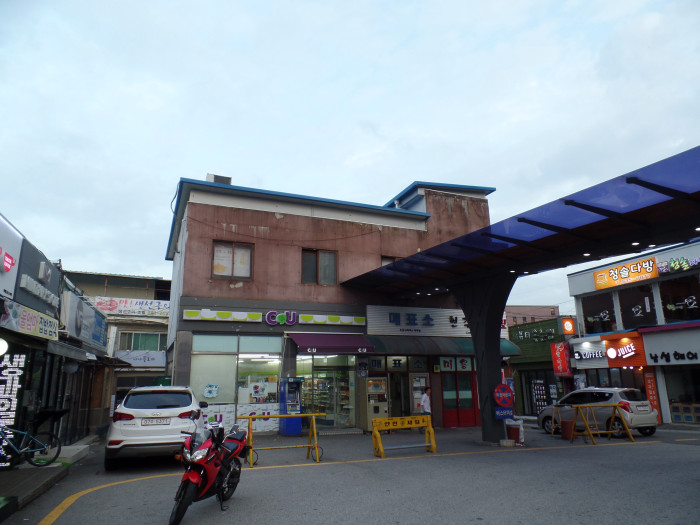
Pocheon Intercity Bus Terminal
The Landscape of a Commercial Space, the Economic Center
Around Jungang-ro 119beon-gil, a road that goes across the bus terminal to Pocheon-dong Community Service Center, you can see buildings that were built in the 1950s. It has the atmosphere of a commercial avenue, where shops, mostly restaurants, line both sides, and Korean-style houses are located in the inner part of the area.
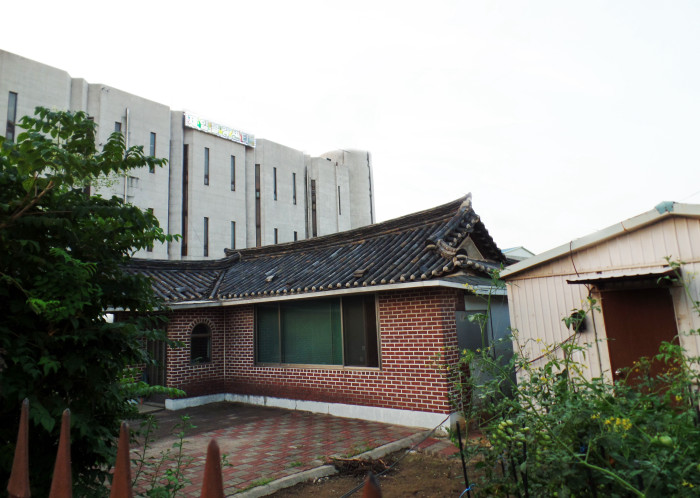
Hanoks hiding beyond the commercial area
The building used as a Chinese restaurant has been in use since 1967. It is hard to see its facade because of the sign on the roadside. The building is seated on the corner of a triangular area, a one-story structure made of cement and bricks, located at the joining point with an alley. It is a structure that has been settled in the region from quite a long time ago as a one-story building.
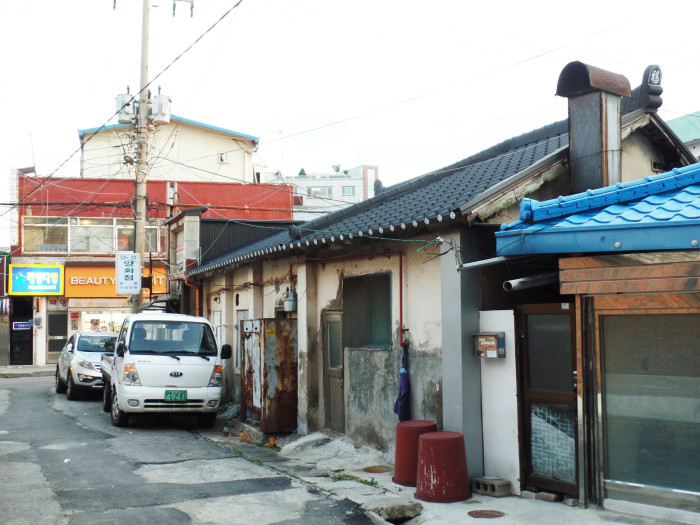
A restaurant in a one-story cement and brick building
Another remarkable building on the boulevard is the two-story shopping center occupied by several shops. Permitted for use in 1976 and starting use in 1981, the building has a straight front and protruding, triangular rear sides according to the shape of the land that is not square. Many two-story shopping malls have remained on the boulevard of Pocheon, and they stand out as having been built in the early 1980s. The facade is now hidden with the sign, but the outside and the simply decorated entrance of the stairs look friendly.
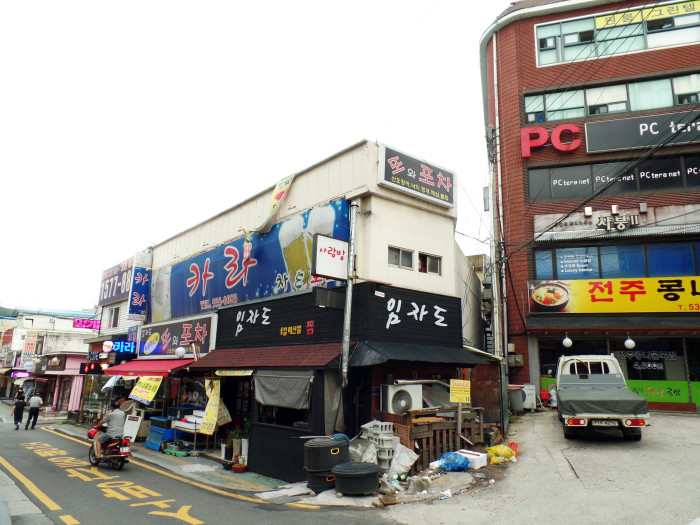
The two-story building at Jungang-ro 119beon-gil
There are small stores on the side of the road that links Jungang-ro with Pocheon-ro, among which you can find coffee shops, many of which can be seen in an urban and agricultural complex city. They are gradually giving way to major coffee franchises, but you can still enjoy the simple landscape of a small town.
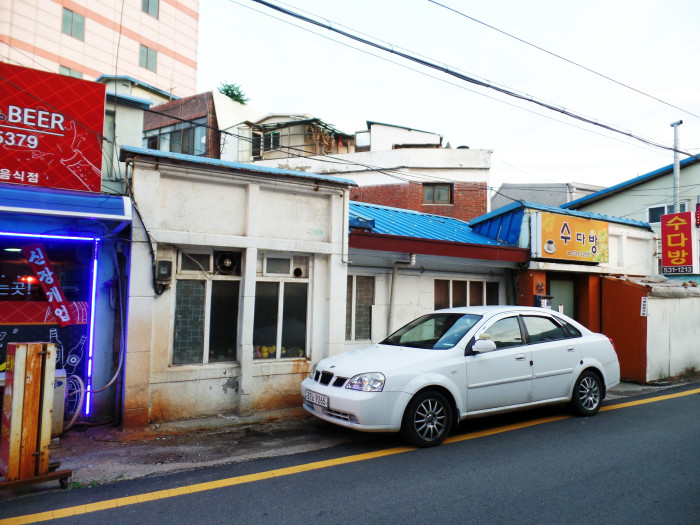
A coffee shop where you can enjoy the landscape of a small town
In local cities, there are supporting organizations and facilities of primary industries like the National Agricultural Cooperative Federation and the National Livestock Cooperatives Federation. To the north of Jungang-ro, not only are there banks and a large post office of modernized structure, but also the modernized warehouse and joint products market of NACF, an important space that lets you observe the urban landscape.
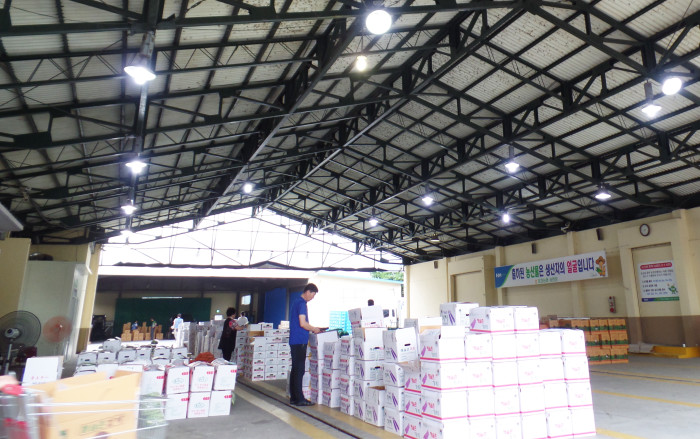
The joint products market of the Pocheon Agricultural Cooperative Federation
To the north of Jungang-ro, there are also residential areas and a nightlife neighborhood. The two-story commercial buildings take a variety of forms on the roadside. The mixed landscape of houses and commercial spaces remains, not a common sight in a large city. The shops and houses built in the 1950s and 60s are on both sides of the grid-shaped alleys, and as you walk down the road you can see structures where a small shop and house share the same roof.
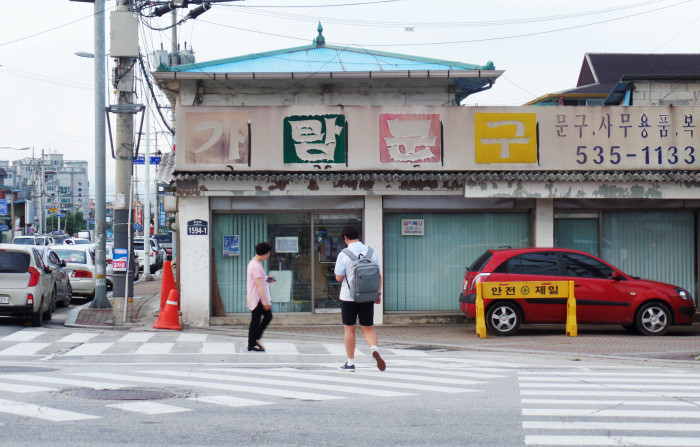
A two-story shopping center on the side of Jungang-ro
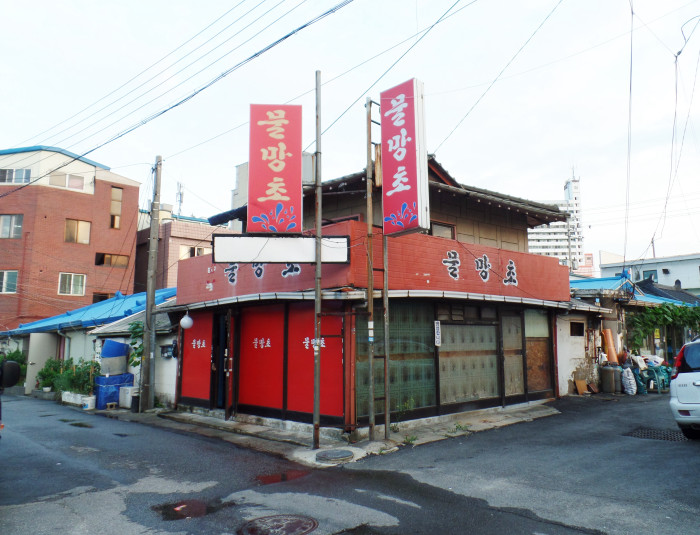
A two-story store north of Jungang-ro

A retail business and house sharing the same roof
School Architecture and Vestiges
The first secondary education facility in Pocheon, Pocheonil High School, was originally founded as Pocheon High School in 1953, then Pocheon General High School, and Pocheon Commercial High School since 1969. Located across Pocheoncheon Stream in the area where you can find the administrative office, the school has a department for livestock breeding and laboratories, characteristic of a school in an urban and agricultural complex city. On the first floor of the school building, there is a picture of the former president Lee Seung-man delivering a congratulatory address at the groundbreaking ceremony, and a monument is set up to commemorate the visit of the president.

The monument of the visit of the president to Pocheonil High School, and the building of laboratories behind it
Today, Pocheon High School is located to the southwest of Pocheon City Hall, re-established as Pocheon Girl’s Middle and High School in 1971. Although the school building has undergone numerous renovations and repairs, the main stairway still has the old handrail poles, which tell us of the original architecture of the 1970s. On the side of the main building is the gymnasium, which has the cornerstone where the name of a former member of the National Assembly is engraved. The long facade of the gym has a curved roof and an entrance on the right side, and the simple structural aesthetics can be detected by its stairs, the canopy at the entrance, and the columns on its rear side.
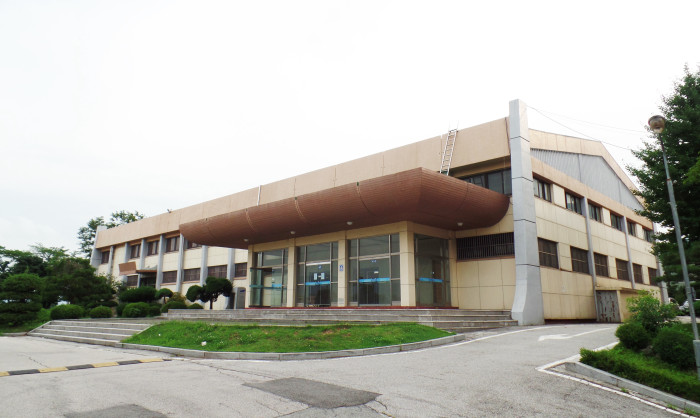
The gymnasium of Pocheon High School
Pocheon-si covers a large territory, with its administrative facilities spread around, allowing us to look into the diverse characteristics of the small towns. Il-dong and I-dong are famous for their foods, namely Korean barbecue and makgeolli (rice wine), and Sanjeong Lake and the Korea National Arboretum are popular among the citizens. Our attention is brought to how, after further development of transportation and city maintenance, the characteristics of the urban and agricultural complex city will be preserved or changed.
<Copyright(c)2002 GGC All rights reserved.>
information
Modern Cultural Heritage in Gyeonggi-do
Writer/ Ho-jin Choi(Head of Jium Urban Architecture Lab )
keywords
- Writer
- GyeongGi Cultural Foundation
- About
- Everything about the GyeongGi arts and culture, GGCF
- homepage
- https://www.ggcf.kr/